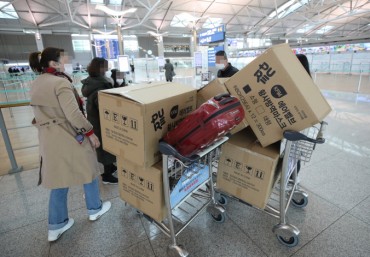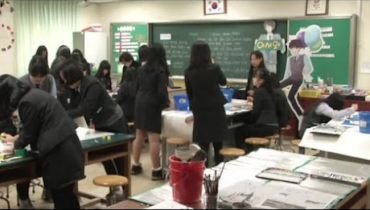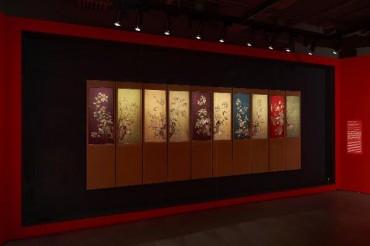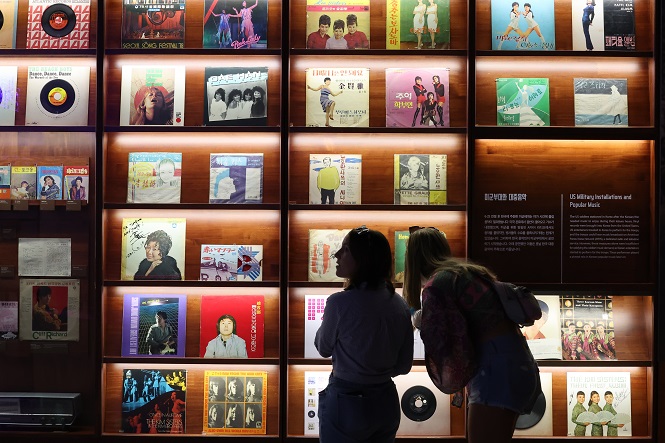
Visitors look at LP records on display at an exhibition, titled “The Pop Culture We Loved, and Rise of the Korean Wave,” at the National Museum of Korean Contemporary History in Seoul on July 20, 2023. (Yonhap)
SEOUL, July 20 (Korea Bizwire) — An exhibition is under way at a national history museum in Seoul providing a perspective into what has shaped today’s “hallyu,” the global boom of Korean pop culture.
The National Museum of Korean Contemporary History in Seoul opened the exhibition, titled “The Pop Culture We Loved, and Rise of the Korean Wave,” on Wednesday.
The exhibit, which runs through Sept. 3, recounts how contemporary Korean culture has been influenced by foreign pop culture from around the world, including American, Japanese and Hong Kong pop culture, and has risen to draw global attention.
“This is basically not an exhibition to promote hallyu or show its history,” Kwon Gi-jun, the curator in charge of the exhibition, said during a press conference held at the museum Thursday to promote the show.
“As a Korean history museum, we intended to suggest a new perspective as an answer to a question of how hallyu has been created and why it succeeded.”
He said the current phenomenon is the result of Korean society’s acceptance of diverse pop culture from around the world in an open-minded way.
The exhibition displays about 1,000 items showcasing the U.S., Hong Kong and Japanese influences on Korean pop music, films and comic books, divided into three parts.
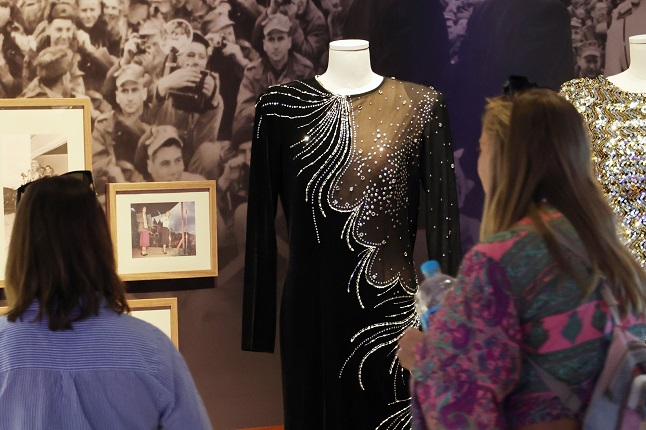
Visitors look at stage outfits worn by Hyun Mee and Lee Geum-hee, who were some of the most popular Korean pop singers in the 1960s, on display at an exhibition, titled “The Pop Culture We Loved, and Rise of the Korean Wave,” at the National Museum of Korean Contemporary History in Seoul on July 20, 2023. (Yonhap)
Upon entering the exhibition hall, visitors will first see two flamboyant stage outfits worn by Hyun Mee and Lee Geum-hee, who were two of the most popular Korean pop singers in the 1960s.
The former died in April this year at age 85.
Just like many other Korean musicians and entertainers at that time, the two began their musical career by performing on stage for the 8th U.S. Army based in South Korea.
Also among the highlights of the first section dedicated to the U.S. culture were the first LP record released in 1956 in the U.S. by Ok Doo-ok, who was the first Korean singer to debut in the country.
There also is an autographed album from Kim Sisters, the first Asian girl group to debut in the U.S.
“East of Make Believe,” the vinyl record released under Ok’s English stage name, Moon Kim, has two tracks — the title track and “Kanda Kanda.”
The album’s discovery a decade ago rewrote the history of Korean music outside the country as Kim Sisters, the K-pop trio that debuted in the U.S. market in 1959, had been known to be the first Korean artist ever to debut in the North American country.
Hong Kong movies and Japanese comic books and animated films were hugely popular in South Korea in the 1970s and ’80s.
The second part of the exhibition displays about 400 videotapes of old Hong Kong movies of all genres while allowing visitors to watch them using a VHS player.
They also can see shelves of illegal copies of hit Japanese manga comics and J-pop albums, and promotional posters for Japanese animation films.
They were domestically released under Korean names since imports of Japanese pop culture were banned until 1998, when South Korea formally lifted the ban.

Promotional posters for hit Hong Kong movies of the 1970s and ’80s are on display at an exhibition, titled “The Pop Culture We Loved, and Rise of the Korean Wave,” at the National Museum of Korean Contemporary History in Seoul on July 20, 2023. (Yonhap)
The third part of the exhibition focuses on the rise of hallyu in the late 1990s and 2000s.
The exhibition showcases K-pop albums, TV shows and movies that have helped to make hallyu a global phenomenon, along with various merchandise K-pop fans purchased.
For those who still cannot grasp the culture’s global popularity, the museum displays newspapers and magazines from the U.S., Japan and Taiwan featuring hallyu or the popularity of Korean pop stars, such as BTS, BLACKPINK, Super Junior, G-Dragon and Psy.
One corner is dedicated to 42 different types of light sticks, ranging from BIGBANG’s “Bang Stick” to EXO’s “LED Stick” and to BTS’ “Amy Bomb.” The museum said most of them were borrowed from K-pop fans who own them.
“One of the biggest features of this exhibition is artists and their fans. Korean pop culture is loved worldwide because the fandom has sprawled globally while communicating with their stars,” Han Soo, the director of the museum, said.
The museum chose to display the sticks because they are considered a symbol of the communication between Korean artists and their fans, he explained.
“We hope many fans will take pride in being true protagonists of the Korean Wave while visiting this exhibition,” he added.
(Yonhap)



